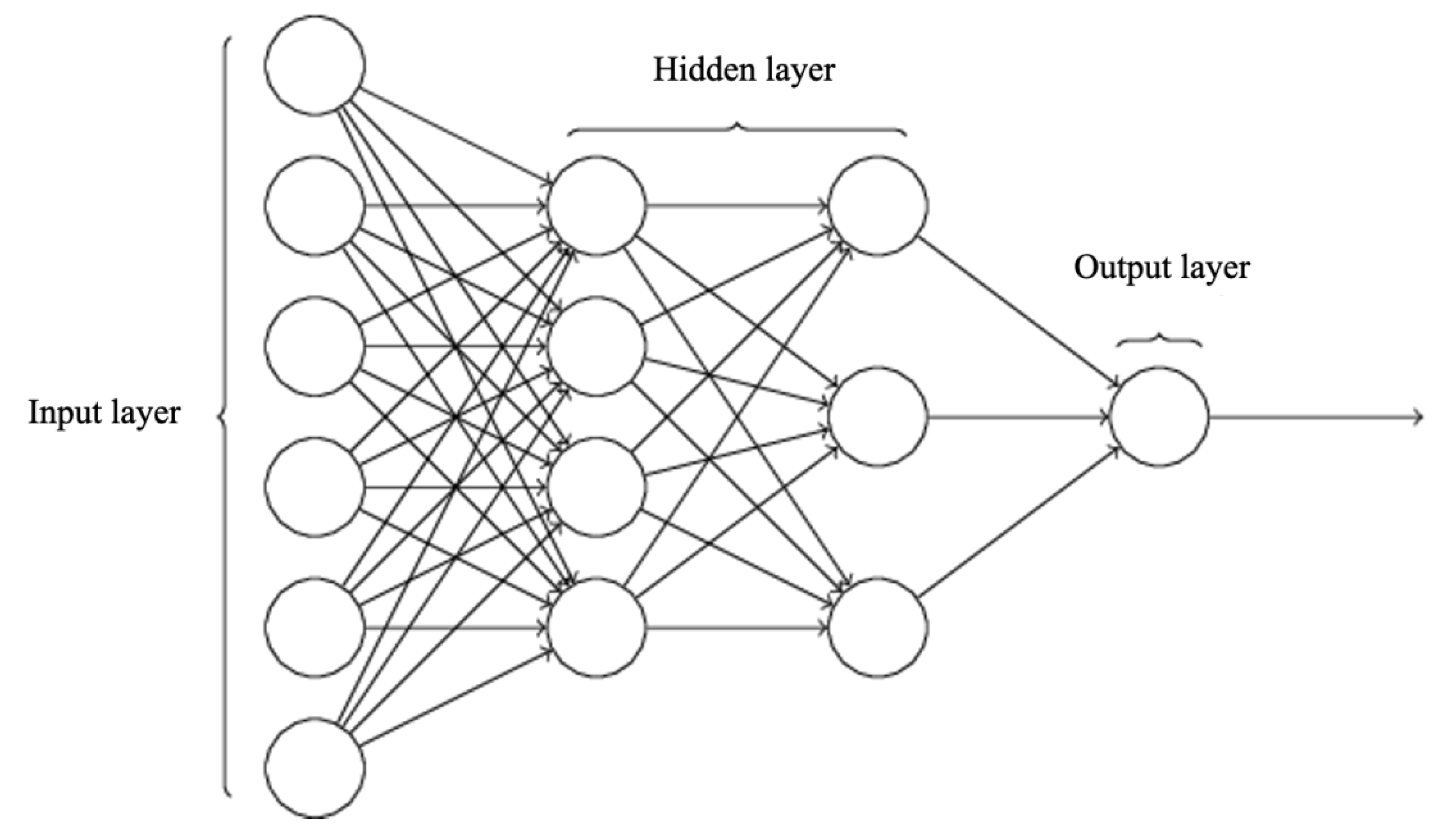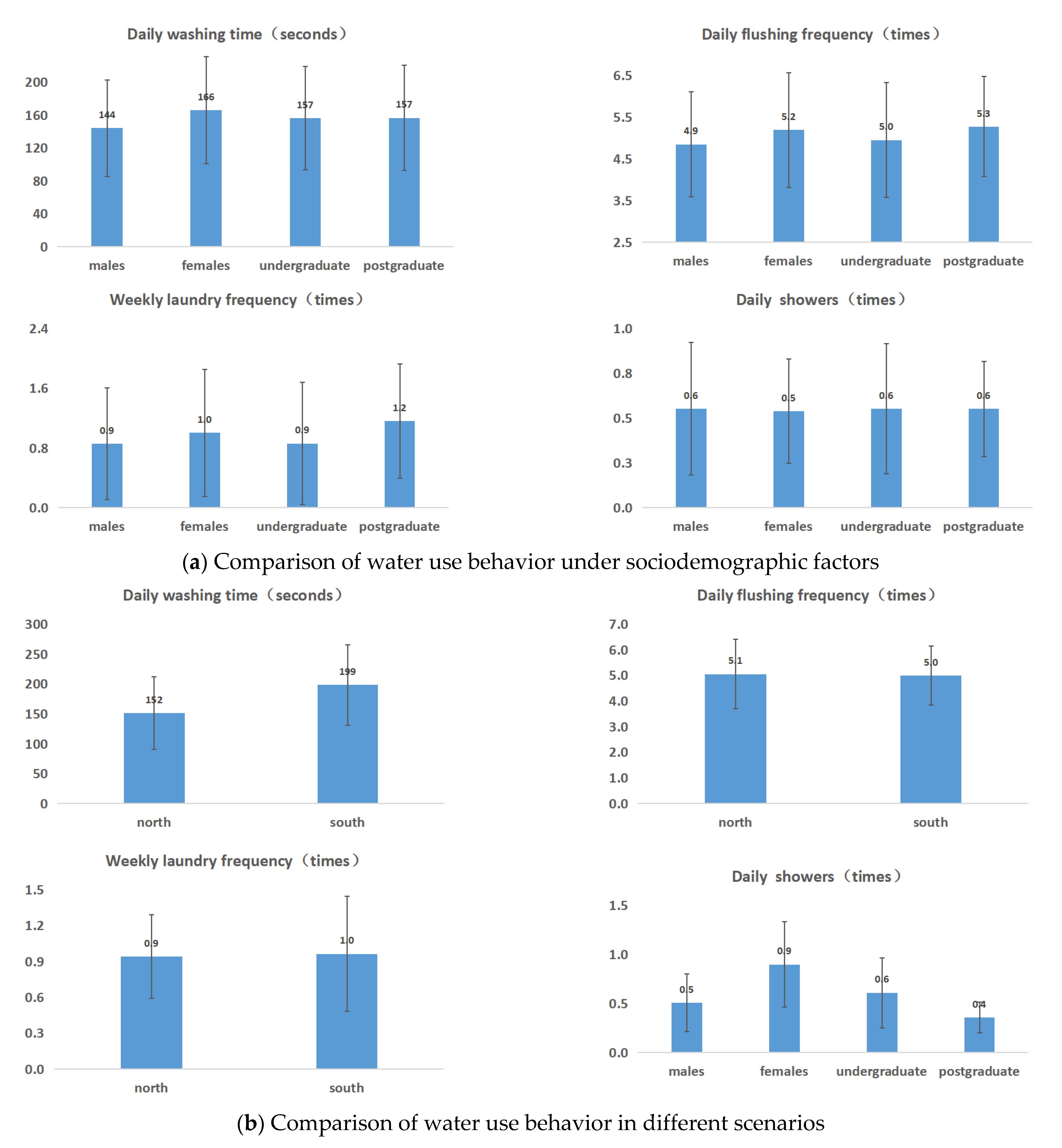Mechanism of Water Use Behavior of College Students Based on the Improved TPB Model
Abstract
1. Introduction
2. Methods and Materials
2.1. Construction of the Theoretical Model
- (a)
- Whether sociodemographic characteristics and environmental characteristics have a significant difference with water use behavior;
- (b)
- Sociodemographic and environmental characteristics have different degrees of influence on water use behavior, and whether there is a certain correlation between the degree of influence of factors and the degree of difference;
- (c)
- Does one influencing factor regulate the impact of other factors on water use behavior if both sociodemographic and environmental characteristics have a significant difference with a certain water use behavior?
2.2. Questionnaire Design and Analysis Method
3. Results and Discussion
3.1. Results of Difference Analysis
3.2. The Results of Impact Analysis
3.3. The Results of Regulating Effect Analysis
3.4. Discussion
4. Conclusions
Author Contributions
Funding
Institutional Review Board Statement
Informed Consent Statement
Data Availability Statement
Conflicts of Interest
References
- Wang, G.Z. The size, structure and developing trend of the Chinese college-age population. Popul. Econ. 2017, 6, 79–89. [Google Scholar]
- Ministry of Education. The general situation of higher education development in our country in 2020. Postgrad. Educ. Res. 2021, 5, 2. [Google Scholar]
- Li, Z.H. Research and application of water saving in universities based on game theory and grey model. Master’s Thesis, Hebei University of Engineering, Handan, China, 2021. (In Chinese). [Google Scholar]
- Yin, X.P. Research on Behavior and Simulation of Centralized Domestic Hot Water Use of College Students. Master’s Thesis, Hunan University, Changsha, China, 2017. Available online: http://cdmd.cnki.com.cn/Article/CDMD-10532-1018023446.htm (accessed on 28 December 2022). (In Chinese).
- Biting, Z. Thermal Energy Research and Utilization Potential Evaluation of Campus Raw Sewage. Master’s Thesis, Tianjin University, Tianjin, China, 2018. Available online: https://www.doc88.com/p-3681686832942.html?r=1 (accessed on 28 December 2022). (In Chinese).
- Wang, Y.; Chen, Y.S.; Weng, J.B.; Jiang, Y.L. Analysis on the characteristics of urban public water consumption in Beijing. Water Supply Drain. 2008, 11, 134–143. [Google Scholar]
- Rabab, I.E.; Ibrahim, M.; Waled, A.B. Water management as a vital factor for a sustainable school. Alex. Eng. J. 2019, 58, 304–313. [Google Scholar]
- Diao, Z.; Zhao, J.; Han, Y.; Zhang, D.; Duan, J. Research on the Hierarchical Water Demand of Urban Residents in Hebei Province. China Rural. Water Hydropower 2023, 1, 74–81. [Google Scholar]
- Patrick, S. The theory of planned behavior. Organ. Behav. Hum. Decis. Process. 1991, 50, 179–211. [Google Scholar]
- Chen, L.S. Research on Energy Consumption Behavior of Urban Residents. Ph.D. Thesis, Dalian University of Technology, Dalian, China, 2009. Available online: https://www.docin.com/p-422153547.html (accessed on 28 December 2022).
- Lin, B.Q.; Qiao, Q. Exploring the acceptance of green electricity and relevant policy effect for residents of megacity in China. J. Clean. Prod. 2022, 378, 134585. [Google Scholar] [CrossRef]
- Lou, S.; Zhang, X.X.; Zhang, D.H. What determines the battery recycling behavior of electric bike users? Introducing recycling convenience into the theory of planned behavior. J. Clean. Prod. 2022, 379 Pt 1, 134560. [Google Scholar] [CrossRef]
- Nekmahmud, M.; Naz, F.; Ramkissoon, H.; Fekete-Farkas, M. Transforming consumers’ intention to purchase green products: Role of social media. Technol. Forecast. Soc. Change 2022, 185, 122067. [Google Scholar] [CrossRef]
- Zhu, J.W.; Zhao, X.; Li, L. Which factors determine students’ water-saving behaviors? Evidence from China colleges. Urban Water J. 2021, 18, 860–872. [Google Scholar] [CrossRef]
- Cradock, A.L.; Everett Jones, S.; Merlo, C. Examining differences in the implementation of school water-quality practices and water-access policies by school demographic characteristics. Prev. Med. Rep. 2019, 14, 100823. [Google Scholar] [CrossRef] [PubMed]
- Maria, C.A.; Damiano, F. Water conservation behavior and environmental concerns: Evidence from a representative sample of Italian individuals. J. Clean. Prod. 2017, 159, 119–129. [Google Scholar]
- Andrew, G.; Stewart, B. Behavioural attitudes towards water saving? Evidence from a study of environmental actions. Ecol. Econ. 2005, 57, 400–414. [Google Scholar]
- Isaac, B.A.; Martin, C. Thoms and melissa parsons. Household water use and conservation behavior: A meta-analysis. Water Resour. Res. 2018, 54, 8381–8400. [Google Scholar]
- Wang, N.; Li, D. Research on Influencing Factors of Forestry Enterprise Management Performance Based on MLP Model. China For. Econ. 2019, 159, 37–40. [Google Scholar]
- Yu, H.X.; Li, X. Analysis and Forecast Model of Major Loss Flight Accidents Based on MLP Neural Networks Method. J. Shanghai Univ. Electr. Power 2016, 32, 504–506. [Google Scholar]
- Zhang, C.; Guo, Y.; Li, M. Review on the development and application of artificial neural network models. Comput. Eng. Appl. 2021, 57, 57–69. [Google Scholar]
- Xie, Y.K.; Ding, M.Q.; Xu, X.; Huang, Y.; Wang, Z.; Yu, K.K. Research on TCM obesity Constitution Classification model based on MLP neural network algorithm. Wirel. Internet Technol. 2021, 18, 37–40. [Google Scholar]
- Tobler, P.N.; Christopoulos, G.I.; O’Doherty, J.P.; Dolan, R.J.; Schultz, W. Risk-dependent reward value signal in human prefrontal cortex. Proc. Natl. Acad. Sci. USA 2009, 106, 7185–7190. [Google Scholar] [CrossRef] [PubMed]
- Shi, L.R.; Zhu, Y.N.; Li, H.H.; Zhao, Y.; Wang, J.H.; Wang, L.Z.; Qu, J.L.; Zhan, L.W. Simulation of residential water consumption and analysis of water-saving potential in Beijing. South-North Water Transf. Water Sci. Technol. 2022, 20, 851–861. (In Chinese) [Google Scholar]



| Elements | Sociodemographic Characteristics | Environmental Characteristics | Water Use Behavior | |||||
|---|---|---|---|---|---|---|---|---|
| Gender | Education Level | Region | Season | Daily Washing Time | Daily Flushing Frequency | Weekly Laundry Frequency | Daily Shower | |
| options | male | undergraduate | north | summer | 0–60 s | 3 times | 0 times | 0.25 times |
| female | postgraduate | south | winter | 60–120 s | 4–6 times | 0.5 times | 0.33 times | |
| — | — | — | — | 120–180 s | 7–8 times | 1 times | 0.5 times | |
| — | — | — | — | 180–240 s | 9–10 times | 2 times | 1 times | |
| — | — | — | — | 240–300 s | — | 3 times | 2 times | |
| — | — | — | — | — | — | 4 times | — | |
| Water Devices/ Products | Water Use Behaviors | Influencing Factors | |||
|---|---|---|---|---|---|
| Gender | Region | Education Level | Season | ||
| Faucets | Daily washing time | 0.001 *** | 0.000 *** | 0.467 | — |
| Toilets | Daily flushing frequency | 0.031 ** | 0.695 | 0.061 * | — |
| Washing machines | Weekly laundry frequency | 0.182 | 0.860 | 0.007 *** | — |
| Showers | Daily showers | 0.758 | 0.000 *** | 0.898 | 0.000 *** |
| Behavior | Item | Gender | Region | Education Level | Season |
|---|---|---|---|---|---|
| Daily washing time | Significance | 0.267 | 0.581 | 0.152 | - |
| Normalization importance | 45.9% | 100% | 26.2% | - | |
| Daily flushing frequency | Significance | 0.264 | 0.239 | 0.497 | - |
| Normalization importance | 53.2% | 48% | 100% | - | |
| Daily laundry frequency | Significance | 0.324 | 0.306 | 0.369 | - |
| Normalization importance | 87.9% | 83% | 100% | - | |
| Daily showers | Significance | 0.073 | 0.296 | 0.079 | 0.552 |
| Normalization importance | 13.3% | 53.5% | 14.3% | 100% |
| Model 1 | Model 2 | Model 3 | ||||||||||
|---|---|---|---|---|---|---|---|---|---|---|---|---|
| Coefficient | Standard Error | t | p | Coefficient | Standard Error | t | p | Coefficient | Standard Error | t | p | |
| const | 122.158 | 11.729 | 10.415 | 0.000 *** | 66.117 | 17.102 | 3.866 | 0.000 *** | 55.11 | 41.026 | 1.343 | 0.180 |
| Gender | 22.107 | 7.154 | 3.09 | 0.002 *** | 48.611 | 11.06 | 4.395 | 0.000 *** | 30.731 | 25.589 | 1.201 | 0.231 |
| Region | 23.461 | 6.958 | 3.372 | 0.001 *** | 58.475 | 35.197 | 1.661 | 0.098 * | ||||
| Gender × region | −6.542 | 22.156 | −0.295 | 0.768 | ||||||||
| ΔF | ΔF(1, 311) = 9.549, p = 0.002 *** | ΔF(1, 308) = 19.316, p = 0.000 *** | ΔF(1, 307) = 14.759, p = 0.000 *** | |||||||||
| Dependent variable: daily washing time | ||||||||||||
| Model 1 | Model 2 | Model 3 | ||||||||||
|---|---|---|---|---|---|---|---|---|---|---|---|---|
| Coefficient | Standard Error | t | p | Coefficient | Standard Error | t | p | Coefficient | Standard Error | t | p | |
| const | 0.119 | 0.065 | 1.843 | 0.066 * | 0.431 | 0.081 | 5.348 | 0.000 *** | 0.142 | 0.197 | 0.72 | 0.472 |
| Region | 0.389 | 0.056 | 6.962 | 0.000 *** | −0.239 | 0.04 | −5.978 | 0.000 *** | 0.637 | 0.173 | 3.684 | 0.000 *** |
| Season | 0.373 | 0.053 | 7.017 | 0.000 *** | 0.006 | 0.158 | 0.037 | 0.971 | ||||
| Region × season | −0.225 | 0.14 | −1.604 | 0.110 | ||||||||
| ΔF | ΔF(1, 322) = 48.476, p = 0.000 *** | ΔF(1, 319) = 35.736, p = 0.000 *** | ΔF(1, 318) = 47.529, p = 0.000 *** | |||||||||
| Dependent variable: Frequency of daily shower | ||||||||||||
Disclaimer/Publisher’s Note: The statements, opinions and data contained in all publications are solely those of the individual author(s) and contributor(s) and not of MDPI and/or the editor(s). MDPI and/or the editor(s) disclaim responsibility for any injury to people or property resulting from any ideas, methods, instructions or products referred to in the content. |
© 2023 by the authors. Licensee MDPI, Basel, Switzerland. This article is an open access article distributed under the terms and conditions of the Creative Commons Attribution (CC BY) license (https://creativecommons.org/licenses/by/4.0/).
Share and Cite
Zhang, L.; Bai, X.; Liu, J.; Bai, Y.; Guan, J. Mechanism of Water Use Behavior of College Students Based on the Improved TPB Model. Processes 2023, 11, 643. https://doi.org/10.3390/pr11020643
Zhang L, Bai X, Liu J, Bai Y, Guan J. Mechanism of Water Use Behavior of College Students Based on the Improved TPB Model. Processes. 2023; 11(2):643. https://doi.org/10.3390/pr11020643
Chicago/Turabian StyleZhang, Lan, Xue Bai, Jialin Liu, Yan Bai, and Jinxin Guan. 2023. "Mechanism of Water Use Behavior of College Students Based on the Improved TPB Model" Processes 11, no. 2: 643. https://doi.org/10.3390/pr11020643
APA StyleZhang, L., Bai, X., Liu, J., Bai, Y., & Guan, J. (2023). Mechanism of Water Use Behavior of College Students Based on the Improved TPB Model. Processes, 11(2), 643. https://doi.org/10.3390/pr11020643






